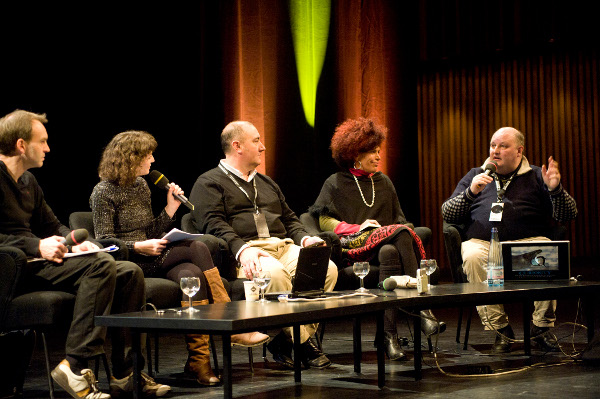Frequency response: Community radio and tactical media

Radio’s tactical future.

(Photo: Jonathan Gröger / transmediale CC BY-NC-SA 2.0)
Public broadcasting’s demise is well documented. Stations and voices with independence and originality have been losing ground to waves of commercialism and conglomerate pressure for decades. The concentration of media ownership into profit-driven powerhouses has seen the airwaves become more crowded and less diverse. Homogeneous programming, covert political influence and cost-cutting exercises have greatly reduced on-air opportunities for quality broadcasting. What future is there for independent radio?
Test Signals, a Sourcefabric project exploring new forms for radio and software, was established to address that very question. Sourcefabric was invited to Berlin in February 2011 as part of transmediale.11, one of Europe’s largest digital culture events. In a digital age characterised by live status updates and connectivity, the festival set out to question both our ability to respond to and our responsibility to act on threats against our freedom. With this in mind, our Radio Tactics panel discussed both the obligation towards, and means to support, independent broadcasting.
Bridging the last mile.
Radio’s death is greatly exaggerated. Ignoring the vitality, potential and relevance that radio still holds over much of the world comes at a high cost. Eric Kluitenberg, head of the media programme at De Balie, reminded us that radio and its makers still have an essential responsibility to maintain multiple, open and accountable broadcasting organisations. The impact of hate media in Rwanda in 1994 and the continued work of Radio La Benevolencija in the region indicates the importance of plurality of voice. Simply put, propaganda is diffused when there are voices of opposition.
Panelist Geraldine de Bastion of newthinking opened the session by saying “radio has the power to bridge the last mile.” Internet connectivity and stable electricity supplies do not reach every corner of the globe - that last mile is sometimes the most crucial one, especially in times of crisis, and there is nothing more suited to bridge it than radio.
As recent events in Tunisia and Egypt showed, the internet cannot always be relied upon in emergency situations. Modular, networked and independent broadcasting methods are much harder to gain control of or to shut down. Maintaining knowledge of how to construct, repair and use these technologies and find new ways to make them cheaper and more efficient remains essential.
The real mass media.
Radio is already a low cost technology, and low cost ensures mass audiences. The panel heard Douglas Arellanes, founder of the non-profit Sourcefabric, recall his first visit to Freetown, Sierra Leone. In a taxi to Citizen FM, he was overwhelmed by the sheer mass of the medium itself. Radios in cars, on windowsills, at street-stalls, with pedestrians. This mass ownership is only made possible by the ubiquity of the receiver, a ubiquity only superceded by mobile phones, many of which contain FM chips and the possibility to receive.
Transmission itself is also low cost, relatively. The US’s landmark Local Community Radio Act of 2010 will see potentially thousands of independent community organisations attracted by the thought of citywide broadcasts available at a fraction of the cost of a traditional FM station.
The establishment and motivation of these communities plays a vital role in radio’s future too. Diana McCarty is a founder of Berlin’s reboot.fm, a great example of a hyperlocal station with a global audience. A unique approach to both content and toolsets sees reboot.fm working with various open source softwares and social networks - SoundCloud and Facebook are two such facilitators - that have allowed their listeners and providers to move away from the iPod generation’s narcissism into a realm of sharing. This takes place both online and in real-life, and spans both their editorial process, their content libraries and even their FM licence and frequency.
From evolution to revolution.
Radio that evolves with new technologies and becomes open to innovation, becomes profitable too. As advertising revenue and funding is siphoned away from traditional broadcast media, concurrently open source software and hardware movements are growing. From Airtime to Arduino, open source is making running a radio station cheaper than ever. There is far greater opportunity to open up the mechanisms of broadcast to new income streams through microdonations, subscriptions, SMS services and beyond. An independence built upon economic self-sufficiency is sustainable.
Another Radio Tactics guest Jonathan Marks is a radio futurologist and self-confessed media ‘insultant’ well aware of the importance of technological innovation. Jonathan spends a lot of time working in sub-Saharan Africa where mobile technology is at the forefront of radio station thinking. Collaboration with mobile companies, use of integrated FM technology and dedicated radio station apps are changing the way broadcasting turns a profit.
Much of this forms part of a larger movement towards hybrid radio, a term we’ve seen a lot in the last 18 months. Mathias Coinchon, Senior Engineer at the European Broadcasting Union, highlighted it in our Open Digital Radio workshop, and expert consultant James Cridland used it as the centrepoint of his keynote at our festival back in the autumn. Hybrid Radio, both as a principle and a platform, allows broadcasters to experiment with the latest radio technology developments, be that RadioDNS, RadioVIS, DAB, DAB+, DMB or DRM. Crucially, it also allows people to connect broadcast radio of any type with the internet.
This hybridity confirms that radio’s future lies in its tactics, in its modes and methods of deployment. By matching cheap technology with instantaneous networks and open standards, radio and its innovators open up a future that has the potential to mirror the frenzied experimentation of the 1900s. By combining the broadcasting vision of one hundred years ago with the experimental technology of today, radio’s tactical future will benefit local urban stations in Berlin as much as early-warning systems in East Asia or networked community broadcasters in Rwanda’s Great Lakes.
Watch the Radio Tactics session in full on the transmediale site.
